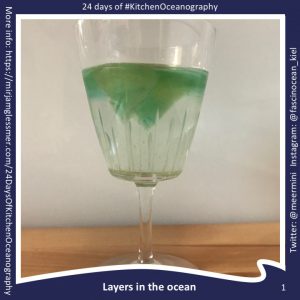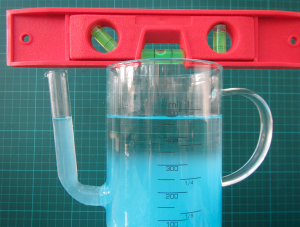
Tag: stratification


Demonstration: Nansen’s “dead water” in a tank!
A ship that is continuously pulled with a constant force suddenly slows down, stops, and then continues sailing as if nothing ever happened? What’s going on there? We will investigate…

Layered latte: A great real-life example of double-diffusive mixing!
Sometimes sitting in a café for a work meeting with #lieblingskollegin Julia can lead to unexpected discoveries of oceanographic processes — in my latte! It’s those little things that inspire blog…

Waves in a density stratification. One of the most beautiful tank experiments I’ve ever seen.
It’s pretty impressive when a mountain moves through a stratification and generates lee waves. But what I find even more impressive: The waves that travel behind the mountain when the…

The one where it would help to understand the theory better (but still: awesome tank experiment!)
The main reason why we went to all the trouble of setting up a quasi-continuous stratification to pull our mountain through instead of sticking to the 2 layer system we…

Lee waves in the tank
Did you guess what we needed the stratification for? Yes — we are moving mountains again! :-) What we want to look at: How a current reacts to an obstacle…

Experiment: Influence of stratification on mixing
A wind stress is applied to the surface of a stratified and a non-stratified tank to cause mixing. This is a pretty impressive experiment to run if you have a…

“Laboratory layered latte” – combining latte and double diffusion. Easily my favourite paper ever!
My friends know me well. Especially A&I, which was proven again when they sent me the link to an article about two things that I am mildly obsessed with: Latte…

Café Latte
Even though most people think I am crazy, I always love watching the convection pattern develop in a hot drink.

Observe a fresh water layer (with your eyes, not a CTD!)
Sometimes you actually see fresh water layers (see with your eyes, not a CTD or some other instrument) floating on top of denser waters, not only in your kitchen and…

Taking the hydrostatic paradox to the next (water) level
How well do people understand hydrostatics? I am preparing a workshop for tomorrow night and I am getting very bored by the questions that I have been using to introduce…

When water doesn’t seek its level
Last week we talked about misconceptions related to hydrostatic pressure, and how water always seeks its level. Today I’m gonna show you circumstances in which this is actually not the…

Influence of stratification on mixing
A wind stress is applied to the surface of a stratified and a non-stratified tank to cause mixing. This is an experiment that Martin and I ran at the JuniorAkademie this…

Creating a continuous stratification in a tank, using the double bucket filling method
Because I am getting sick of stratifications not working out the way I planned them. Creating stratifications, especially continuous stratifications, is a pain. Since I wanted a nice stratification for an…

Mixing in a non-stratified and in a stratified tank
A wind stress is applied to the surface to cause mixing. This is an experiment that I have been wanting to do for a long time, but somehow it never…

Forced internal waves in a continuous stratification
Plus all kinds of dyes. (deutscher Text unten) Using the continuous salinity stratification created yesterday, Rolf and Daniel conducted a really cool experiment: They forced internal waves and watched them…

Why we absolutely need toy boats at the JuniorAkademie
Luckily I’m not the only one believing that we absolutely need remotely controlled boats! – Zum Glück bin ich nicht die Einzige, die findet, dass wir ferngesteuerte Boote brauchen! Mein…

Salt fingering – DIY
How to easily set up the stratification for the salt fingering process. Setting up stratifications in tanks is a pain. Of course there are sophisticated methods, but when you want…

Diffusive layering. Or: This is not a trick question!
The “other” double-diffusive mixing process. After having talked extensively about double diffusive mixing in my courses, I tend to assume that students not only remember that there is such thing as…

Salt fingering
How to show my favorite oceanographic process in class, and why. As I mentioned in this post, I have used double-diffusive mixing extensively in my teaching. For several reasons: Firstly,…

Double-diffusive mixing
On the coolest process in oceanography. My favorite oceanographic process, as all of my students and many of my acquaintances know, is double-diffusive mixing. Look at how awesome it is:…

Ship-generated internal waves
A tank experiment showing ship-generated internal waves. When entering a fjord from the open ocean by ship, it can sometimes be noted that the speed of the ship changes even…